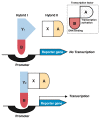Proteomics in alcohol research
Abstract
The proteome is the complete set of proteins in an organism. It is considerably larger and more complex than the genome--the collection of genes that encodes these proteins. Proteomics deals with the qualitative and quantitative study of the proteome under physiological and pathological conditions (e.g., after exposure to alcohol, which causes major changes in numerous proteins of different cell types). To map large proteomes such as the human proteome, proteins from discrete tissues, cells, cell components, or biological fluids are first separated by high-resolution two-dimensional electrophoresis and multidimensional liquid chromatography. Then, individual proteins are identified by mass spectrometry. The huge amount of data acquired using these techniques is analyzed and assembled by fast computers and bioinformatics tools. Using these methods, as well as other technological advances, alcohol researchers can gain a better understanding of how alcohol globally influences protein structure and function, protein-protein interactions, and protein networks. This knowledge ultimately will assist in the early diagnosis and prognosis of alcoholism and the discovery of new drug targets and medications for treatment.
Figures





References
-
- Alivisatos AP. Less is more in medicine—Sophisticated forms of nanotechnology will find some of their first real-world applications in biomedical research, disease diagnosis and, possibly, therapy. Scientific American. 2001;285:66–73. - PubMed
-
- Anni H, Israel Y. Characterization of adducts of ethanol metabolites with cytochrome c. Alcoholism: Clinical and Experimental Research. 1999;23:26–37. - PubMed
-
- Anni, H., Nikolaeva, O., and Israel, Y.Selection of phage display library peptides recognizing ethanol targets on proteins Alcohol 25201–209.2001a - PubMed
-
- Anni, H., Pristatsky, P., Abdi-Oskouei, F., et alBinding of acetaldehyde to cysteinyl-glycine Alcoholism: Clinical and Experimental Research 25S719.2001b
-
- Anni H, Luo J, Israel Y. Combinatorial phage-displayed peptide libraries as sources of inhibitors of aldehyde dehydrogenase. Alcoholism: Clinical and Experimental Research. 2002;26S:1074.
Publication types
MeSH terms
Grants and funding
LinkOut - more resources
Full Text Sources
Medical
